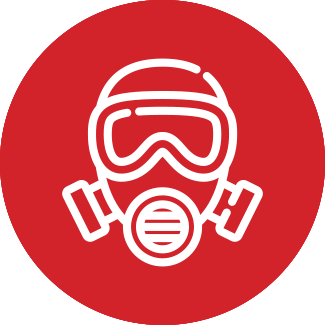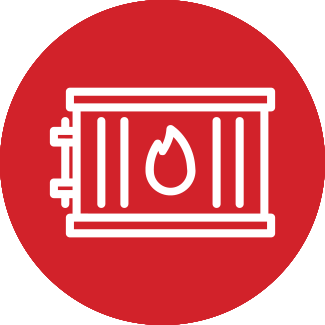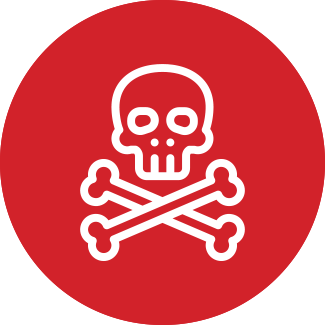Your Guide to HAZMAT Classes in Transportation
The transportation of chemicals comes with significant financial, environmental, and health-related risks. That’s why the US and other countries have robust laws and regulations in place to ensure proper safety precautions and regulations are strictly followed. Around the world, hazardous materials regulations change frequently, and experienced 4PLs have to be diligent about staying up to date on those changes. Our Infographic: Achieve Chemical Compliance Quickly & Effectively is an excellent resource for chemical manufacturers to learn how to keep up!
It’s critical for chemical manufacturers to partner with a 4PL that specializes in, understands, and complies with the regulations and responsibilities set by the federal government. Today, we’re going back to the basics with a quick look at the various types of HAZMAT Classes defined by the FMCSA.
 Class 1: Explosives
Class 1: Explosives
Explosives are any substance or device that functions by explosion, or wherein a chemical reaction functions in a similar manner, even if not designed to explode. Explosives come in 6 separate divisions, from those that pose a risk of a massive explosion, to extremely insensitive but potentially explosive substances. Explosive transportation comes with considerable risk and must be handled with extreme care. As we’ve recently seen in the Beirut explosion, the results of improperly storing and handling explosive chemicals can be catastrophic.

 Class 2: Gases
Class 2: Gases
Class 2 includes all gases that are compressed and stored for transportation and comes in three divisions: flammable gases (acetylene, propane, hydrogen), non-flammable/non-toxic (nitrogen, neon, carbon dioxide), and toxic (fluorine, chlorine). Great care must be taken in the equipment and processes used in the transportation and distribution of gaseous chemicals to avoid any damage to the valves and connections of their storage containers.
 Class 3: Flammable Liquids
Class 3: Flammable Liquids
Flammable liquids are those with a flashpoint of 141 degrees F or lower or any material in a liquid phase with a flashpoint at or above 100 degrees F that is intentionally heated and transported in bulk packaging at or above its flashpoint. Simply put, it’s very easy for these liquids to ignite, and they pose a serious risk to people and property when mishandled. Flammable liquids include diethyl ether, gasoline, acetone, kerosene, and diesel.
 Class 4: Flammable Solids
Class 4: Flammable Solids
Flammable solids are materials that can easily combust in the presence of an ignition source under normal circumstances. They don’t need artificial variables or accelerants catch fire, and are further organized into standard flammable solids (nitrocellulose, strike-anywhere matches), spontaneously combustible solids (white phosphorus), and solids that are flammable when wet (sodium, calcium, potassium).
 Class 5: Oxidizing Substances and Organic Peroxides
Class 5: Oxidizing Substances and Organic Peroxides
Oxidizing chemicals yield oxygen in a reaction, thereby speeding up the development of a fire, increasing the intensity of a fire, and potentially causing combustible materials to combust without an obvious source of ignition. Oxidizing agents that are not organic peroxides include calcium hypochlorite, hydrogen peroxide, and potassium permanganate. Organic peroxides include benzoyl peroxides and cumene hydroperoxide.
Class 6: Toxic and Infectious Substances
Toxic and infectious substances are those other than gases that are so harmful to humans that special care must be taken in transportation and storage. Toxic substances can cause injury or death when inhaled, swallowed, or absorbed through the skin. Examples include potassium cyanide, mercuric chloride, and many pesticides. Infectious substances are biohazardous materials that can include medical specimens and laboratory cultures.
 Class 7: Radioactive Substances
Class 7: Radioactive Substances
Radioactive substances are materials that emit radiation, such as uranium and plutonium. Radioactive materials can cause monumental damage to people and ecosystems when handled improperly or spilled.
 Class 8: Corrosive Substances
Class 8: Corrosive Substances
Corrosive substances are those that can quickly dissolve organic tissue or corrode metals. These include acids, such as sulfuric acid and hydrochloric acid, and alkalis, such as potassium hydroxide and sodium hydroxide. They can often burn or harm the skin, eyes, and respiratory tract, and are further separated into groups based on how quickly they destroy skin tissue.
 Class 9: Miscellaneous Hazardous Materials
Class 9: Miscellaneous Hazardous Materials
Miscellaneous hazardous materials include anything that doesn’t fall into any of the previous categories, such as asbestos and dry ice. They include materials with anesthetic, noxious, or similar properties, and specifically defined hazardous waste and pollutants.
With so many different categories of hazardous materials, it’s easy to see why it’s vital to have an experienced 4PL in your corner to maintain complete HAZMAT compliance, monitor and act on rapidly changing import and export regulations around the world, and avoid fines and other issues.
Check out our Infographic: Achieve Chemical Logistics Compliance Quickly & Effectively for answers to important chemical logistics questions, and learn how to save time and money while eliminating unnecessary risk from all modes of transport in your chemical su
Back to Resources


